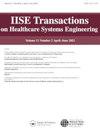利用深度学习集成方法从电子健康记录中识别心脏病风险因素
IF 1.5
Q3 HEALTH CARE SCIENCES & SERVICES
IISE Transactions on Healthcare Systems Engineering
Pub Date : 2023-04-21
DOI:10.1080/24725579.2023.2205665
引用次数: 0
摘要
摘要心脏病是世界范围内死亡的主要原因。几十年来,心脏病专家一直试图确定心脏病的风险因素,以促进其预测、预防和治疗。近年来,电子健康记录(EHR)已成为检测这些风险因素(如吸烟、肥胖和糖尿病)的宝贵来源。然而,由于EHR包括自由格式和非结构化文本的临床笔记,这使得心脏病专家检索相关信息变得乏味,因此挑战依然存在。为了解决这个问题,我们设计了一种基于深度学习的集成方法,从EHR中自动识别心脏病风险因素。该方法可以有效地从EHR中提取语义信息,并以高性能自动识别风险因素。特别是,这种方法不需要任何关于该疾病的外部领域知识,因为实现了强大的双向编码器变换表示(BERT)方法来对临床笔记的判别特征进行编码。然后将提取的特征馈送到条件随机场(CRF),以识别所有可能的风险因素指标。实验结果表明,在没有外部知识可用的情况下,所提出的方法实现了最先进的性能。本文章由计算机程序翻译,如有差异,请以英文原文为准。
Identifying heart disease risk factors from electronic health records using an ensemble of deep learning method
Abstract Heart disease is a leading cause of death worldwide. For decades, cardiologists have attempted to identify heart-disease risk factors to facilitate its prediction, prevention, and treatment. In recent years, electronic health records (EHRs) have become a valuable source for detecting these risk factors (e.g. smoking, obesity, and diabetes). However, challenges persist as EHRs include clinical notes in free-form and unstructured text, making it tedious for cardiologists to retrieve relevant information. To resolve this problem, we devised a deep-learning-based ensemble approach to automatically identify heart-disease risk factors from EHRs. This proposed approach can efficiently extract semantic information from EHRs and automate risk-factor identification with high performance. In particular, this approach does not require any external domain knowledge about the disease because a powerful Bidirectional Encoder Representations from Transformers (BERT) method is implemented to encode the discriminative features of clinical notes. The extracted features are then fed to conditional random fields (CRF) to identify all possible risk-factor indicators. Experimental results show that, in a scenario where no external knowledge is available, the proposed approach achieves state-of-the-art performance.
求助全文
通过发布文献求助,成功后即可免费获取论文全文。
去求助
来源期刊

IISE Transactions on Healthcare Systems Engineering
Social Sciences-Safety Research
CiteScore
3.10
自引率
0.00%
发文量
19
期刊介绍:
IISE Transactions on Healthcare Systems Engineering aims to foster the healthcare systems community by publishing high quality papers that have a strong methodological focus and direct applicability to healthcare systems. Published quarterly, the journal supports research that explores: · Healthcare Operations Management · Medical Decision Making · Socio-Technical Systems Analysis related to healthcare · Quality Engineering · Healthcare Informatics · Healthcare Policy We are looking forward to accepting submissions that document the development and use of industrial and systems engineering tools and techniques including: · Healthcare operations research · Healthcare statistics · Healthcare information systems · Healthcare work measurement · Human factors/ergonomics applied to healthcare systems Research that explores the integration of these tools and techniques with those from other engineering and medical disciplines are also featured. We encourage the submission of clinical notes, or practice notes, to show the impact of contributions that will be published. We also encourage authors to collect an impact statement from their clinical partners to show the impact of research in the clinical practices.
 求助内容:
求助内容: 应助结果提醒方式:
应助结果提醒方式:


